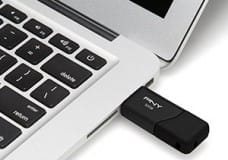Which Thumbdrive?
 Which Thumbdrive? a reader asks…
Which Thumbdrive? a reader asks…
Hi Chris, do you have a recommendation on what thumbdrive I should use to backup my files on my 2014 Macbook Air? I don’t have a whole lot, so I don’t think I need a really big external hard drive. thanks!
There are plenty of cheap thumbdrives out there, but I should warn you that the quality can vary. I’d suggest you stick with good brand-name drives from companies like Kingston, Crucial, PNY and SanDisk.
 That said, many computer supply stores use the internal components from one of these high-quality manufacturers, and just put their own custom-branded enclosure around it. I like MicroCenter thumbdrives in sizes from 4gb ($3.49 ea.) to 128gb ($28.99 ea.). While you may see advertising for ‘secure’, UEFI, ‘encrypted’ and other keywords, for the most part these aren’t going to matter to the consumer.
That said, many computer supply stores use the internal components from one of these high-quality manufacturers, and just put their own custom-branded enclosure around it. I like MicroCenter thumbdrives in sizes from 4gb ($3.49 ea.) to 128gb ($28.99 ea.). While you may see advertising for ‘secure’, UEFI, ‘encrypted’ and other keywords, for the most part these aren’t going to matter to the consumer.
 Before you shop for a thumbdrive, you might want to verify exactly how much space you’ll need. In your Mac, click the Apple (top-left corner) and select About this Mac. Then look at the storage tab. Please note that about 11gb of storage space will be taken for the operating system, so you can discount that much from whatever is being used. For those with Windows 10, you can open File Explorer, click the C: drive on then navigate to C:/Users/[your user account] and then select all the personal folders (Desktop, Documents, Downloads, Favorites, Music, Pictures & Videos) by holding down the Ctrl key while you click on each one of the folders in turn to select them. Let go of the Ctrl key and right-click on any of the selected folders, and then left-click on the Properties menu item.
Before you shop for a thumbdrive, you might want to verify exactly how much space you’ll need. In your Mac, click the Apple (top-left corner) and select About this Mac. Then look at the storage tab. Please note that about 11gb of storage space will be taken for the operating system, so you can discount that much from whatever is being used. For those with Windows 10, you can open File Explorer, click the C: drive on then navigate to C:/Users/[your user account] and then select all the personal folders (Desktop, Documents, Downloads, Favorites, Music, Pictures & Videos) by holding down the Ctrl key while you click on each one of the folders in turn to select them. Let go of the Ctrl key and right-click on any of the selected folders, and then left-click on the Properties menu item.
 That will give you a smaller window and show you the total size in use in the locations you selected. I think it’s important to not just look for a thumbdrive close to that size, but to seriously consider a thumbdrive at least twice the size or higher. So for this example, I have 24.4gb in use, and I’d want to buy a thumbdrive that’s bigger than 50gb.
That will give you a smaller window and show you the total size in use in the locations you selected. I think it’s important to not just look for a thumbdrive close to that size, but to seriously consider a thumbdrive at least twice the size or higher. So for this example, I have 24.4gb in use, and I’d want to buy a thumbdrive that’s bigger than 50gb.
Thumbdrives come in progressively doubled sizes, so you can get 4gb, 8gb, 16gb, 32gb, 64gb, 128gb, and 256gb. So for this example, the 64gb thumbdrive is the smallest one I’d consider. Given that these items have dropped in price so far, I’d even suggest going for the 128gb size thumbdrive.
 Right now, the largest size easily available is 256gb – for example Staples has a SanDisk 256gb thumbdrive for $100 (you can order it online here). So there’s still a big jump in price between the 128gb and 256gb size. You can get an even larger size, but they start to become a bit bulky compared to a normal-sized thumbdrive. For example, Kingston will sell you a 512gb or 1tb or even 2tb ‘thumbdrive’ (the DataTraveler HyperX Predator or Ultimate, get them here), but they really stretch the notion of thumbdrive – being much wider and longer than the norm. And a heckuva lot more expensive!
Right now, the largest size easily available is 256gb – for example Staples has a SanDisk 256gb thumbdrive for $100 (you can order it online here). So there’s still a big jump in price between the 128gb and 256gb size. You can get an even larger size, but they start to become a bit bulky compared to a normal-sized thumbdrive. For example, Kingston will sell you a 512gb or 1tb or even 2tb ‘thumbdrive’ (the DataTraveler HyperX Predator or Ultimate, get them here), but they really stretch the notion of thumbdrive – being much wider and longer than the norm. And a heckuva lot more expensive!
The second consideration is what type of USB – 2.0 or 3.0 (or now 3.1). The 3.0/3.1 USB ports look almost exactly like the USB 2.0 ports except that the inner wafer is blue instead of grey, black or white. Even if your current computer doesn’t have USB 3.0 ports on it, it makes sense to buy a USB 3.0 thumbdrive since there’s not a whole lot of difference in price. Plus, your thumbdrive just might outlast your computer, and your next one will most likely have one or more USB 3.0 ports. The difference is speed – the 3.0 ports will transfer data about 10 times faster than 2.0 ports and devices.
 The third consideration is one of physical size. As I noted above, the really monster-sized thumbdrives are also physically monster-sized. Most other thumbdrives will be about the size of…your thumb! But there are some that are substantially smaller, which may be useful. Such as if you have a laptop and want to leave it plugged into a USB port all the time (for extra storage space). An example is this SanDisk UltraFit thumbdrive, which will barely jut out from the side of your laptop. These come from 4gb to 128gb and aren’t really any more expensive than the regular thumbdrives.
The third consideration is one of physical size. As I noted above, the really monster-sized thumbdrives are also physically monster-sized. Most other thumbdrives will be about the size of…your thumb! But there are some that are substantially smaller, which may be useful. Such as if you have a laptop and want to leave it plugged into a USB port all the time (for extra storage space). An example is this SanDisk UltraFit thumbdrive, which will barely jut out from the side of your laptop. These come from 4gb to 128gb and aren’t really any more expensive than the regular thumbdrives.
If you just want to buy a plain-old USB 3.0 thumbdrive, then I don’t think you can go wrong buying any of the leading brands, and you’ll find some great prices at Amazon.com (hint, just search on ‘thumb drive’). One final consideration would be the construction of the enclosing case. Some have removable caps that cover the USB jack, some have sliding covers, and some have no covers at all. I actually prefer the removable cap kind where you can pop the cap onto the other end for safekeeping while using it, and then fully cover the vulnerable USB jack when you’re not. I keep several of these handy in my pocket for odd and end needs.
This website runs on a patronage model. If you find my answers of value, please consider supporting me by sending any dollar amount via:
or by mailing a check/cash to PosiTek.net LLC 1934 Old Gallows Road, Suite 350, Tysons Corner VA 22182. I am not a non-profit, but your support helps me to continue delivering advice and consumer technology support to the public. Thanks!






